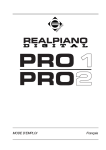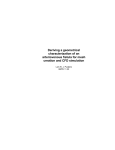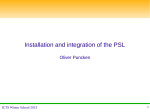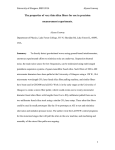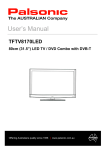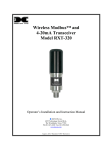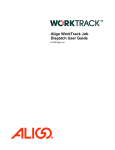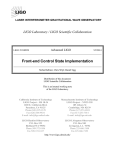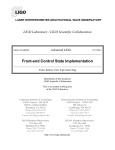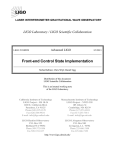Download T0900278-v2_Preparation and hazard analysis for test - DCC
Transcript
LIGO-T0900278-v2 Advanced LIGO LIGO Laboratory / LIGO Scientific Collaboration ADVANCED LIGO LIGO-T0900278-v2 2nd July 2009 ALIGO NP-type: Preparations and hazard analysis for test hangs at LASTI in July/August 2009 Mariëlle van Veggel1, Mark Barton4, Tim Bodiya3, Alan Cumming1, Liam Cunningham1, Giles Hammond1, Gregg Harry3, Karen Haughian1, Alastair Heptonstall2, Jim Hough1, Russell Jones1, David Kelley3, Rahul Kumar1, Rich Mittleman3, Norna Robertson2,1, Sheila Rowan1, Brett Shapiro3, Ken Strain1, Kirill Tokmakov1, Alexander Wanner1 1 Institute for Gravitational Research, University of Glasgow 2 3 California Institute of Technology, LIGO Project Massachusetts Institute of Technology, LIGO Project 4 LIGO Hanford Observatory, LIGO Project Distribution of this document: LIGO Science Collaboration. This is an internal working note of the LIGO Project. Massachusetts Institute of Technology California Institute of Technology LIGO Project – MS 18-34 LIGO Project – NW22-295 1200 E. California Blvd. Institute for Gravitational 185 Albany St Pasadena, CA 91125 Research Cambridge, MA 02139 Phone (626) 395-2129 Phone (617) 253-4824 University of Glasgow Fax (626) 304-9834 Fax (617) 253-7014 Kelvin Building E-mail: [email protected] E-mail: [email protected] Glasgow G12 8QQ Phone: +44 (0)141 330 3340 LIGO Hanford Observatory LIGO Livingston Observatory Fax: +44 (0)141 330 6833 P.O. Box 1970 P.O. Box 940 Web: www.physics.gla.ac.uk/igr/ Mail Stop S9-02 Livingston, LA 70754 Phone 225-686-3100 Richland WA 99352 Phone 509-372-8106 Fax 225-686-7189 Fax 509-372-8137 http://www.ligo.caltech.edu LIGO-T0900278-v2 Advanced LIGO Introduction ....................................................................................................................................... 2 1 Reference documents ................................................................................................................. 4 2 Goals........................................................................................................................................... 5 3 Prospected time schedule........................................................................................................... 5 4 Safety equipment........................................................................................................................ 7 5 Check fibre pulling machine and fibre pulling and testing ..................................................... 7 5.1 Check fibre pulling machine............................................................................................ 7 5.2 Pull fibres........................................................................................................................... 8 5.3 Characterise fibres............................................................................................................ 9 5.3.1 Dimensional Characterisation machine .................................................................... 10 5.3.2 Proof load test ........................................................................................................... 11 5.3.3 Vertical bounce frequency measurement.................................................................. 11 5.4 6 Store fibres....................................................................................................................... 11 Set-up lower structure and lower structure assembly tooling ................................................ 11 6.1 7 Lower structure assembly tooling ................................................................................. 12 Weld fibres and suspend .......................................................................................................... 12 7.1 Welding set-up ................................................................................................................ 12 7.1.1 Weld scaffolding....................................................................................................... 12 7.1.2 Prepare the fibre........................................................................................................ 12 7.1.3 Fibre installation ....................................................................................................... 13 7.2 Weld fibres....................................................................................................................... 13 7.3 Straighten welds.............................................................................................................. 14 7.4 Suspend the test mass ..................................................................................................... 14 8 Remove ‘old’ ears from penultimate mass.............................................................................. 14 9 List of required items ............................................................................................................... 16 10 Hazard analysis.................................................................................................................... 18 Version v1 15th June 2009 First draft of report for comment to Norna Robertson Introduction In the period of the 6th of July until the 7th of August work will be ongoing at LASTI to execute two tests in which an aluminium dummy test mass is suspended from another dummy test mass by four silica fibres, welded to silica ‘ears’ that are bonded to silica disc inserts. These slot into the aluminium mass using aluminium disc insert plates. 2 Advanced LIGO LIGO-T0900278-v2 These tests are performed to practice and refine procedures for the fully monolithic suspension that is scheduled to be fabricated at LASTI in September 2009. The three main steps will consist of a preparation of the laboratory in the first week, pulling of fibres; setting up welding equipment in the second week and making the first suspension in the third week. Finally, in a fourth and slightly separated week, there will be a second test hang. This preparation document contains a list of relevant documents, a schedule of the activities, a detailed description, a required items check list, and some words on the risk assessment. 3 LIGO-T0900278-v2 Advanced LIGO 1 Reference documents Will be added asap. Design documentation fibre pulling machine D050… D050… D060… D060… Design documentation the lower structure assembly D070… D070… D070… D070…. Design documentation on lower structure assembly tooling D080359 Turntable pallet assembly Documentation on welding set-up T0900064 Alignment of laser articulated arm for welding suspensions Back ground documents T070138-00-K Ribbon/Fibre Length Budget User manual dimensional characterisation machine User manual bounce tester User manual fibre pulling machine 4 Advanced LIGO LIGO-T0900278-v2 2 Goals Goals of the visit are to: 1) Prepare pulling machine 2) Pull and test fibres for 2 test suspensions and possibly for the monolithic suspension 3) Prepare the welding set-up and masses 4) Weld fibres into a first suspension and suspend the test mass on the penultimate mass 5) Weld fibres into a second suspension and suspend the test mass on the penultimate mass 6) Possibly move one of the suspensions to test transport and integrity of the fibres 3 Prospected time schedule The time schedule shown in table 3.1 is intended as a rough guide on the activities that will take place leading to the final goal of performing 2 test suspensions. Table 3.1 Draft time schedule Tuesday Wednesday Thursday Friday 07-07-2009 08-07-2009 09-07-2009 10-07-2009 Monday Tuesday Wednesday Thursday Friday 13-07-2009 14-07-2009 15-07-2009 16-07-2009 17-07-2009 Monday Tuesday Wednesday Thursday Check pulling machine Prepare stock in fuse ends Pull fibres Strength test a few fibres to test actual strength is high enough Pull more fibres Profile fibres Bounce test fibres Proof test fibres Check articulated arm Practice bench top welds Set-up structure with masses Check lever arm clamp Fit checks of fibre holder and baffles Remove ears from PM 5 Advanced LIGO LIGO-T0900278-v2 20-07-2009 21-07-2009 22-07-2009 23-07-2009 Monday Tuesday Wednesday Thursday Friday 03-08-2009 04-08-2009 05-08-2009 06-08-2009 07-08-2009 Fit in fibre holder and baffles Weld in fibres De-stress fibres Suspend the test mass Fit in fibre holder and baffles Weld in fibres De-stress fibres Suspend the test mass Transport tests of the suspension 6 Advanced LIGO LIGO-T0900278-v2 4 Safety equipment • 8x Safety glasses • 8x laser safety glasses that are marked for 10600 nm and have an optical density of 6 or higher • Gloves (disposable) • 1x ULPA filtered vacuum cleaner • 1x glass/sharp container • 1x ergo arm • 2x respirator masks with P2 filters fit checked for the personnel using it • 10x sandblasted aluminium baffles • 1x Lexan bodyshield • 3x Lexan welding screens 5 Check fibre pulling machine and fibre pulling and testing Safety glasses and gloves are worn at all times. The laser is operated only by trained laser operator. 5.1 Check fibre pulling machine The fibre pulling machine is checked according to the standard operating procedure. The checks include: • A check of the laser cooling system (it is working well and there are no coolant leaks) • Safety check of the laser, laser cooling, and interlocking • Laser power with (water cooled) power meter • Check laser alignment with red guide laser • Align mirrors for fibre pulling • Pull test fibres and strength test those to confirm average strength is high enough. 7 Advanced LIGO LIGO-T0900278-v2 Figure 1 Fibre pulling machine at LASTI 5.2 Pull fibres • A piece of 94 mm Suprasil 2A ∅ 3 mm stock is cut using a diamond scribe (for 628mm fibre – check lengths!!). • Clean the stock by wiping with and optical cloth soaked with acetone or chloroform, followed by a wipe with methanol. • Prepare Araldite 2012 epoxy adhesive • Glue into fuse ends on either end (label the upper fuse end with a number). Ensure no adhesive lands on the stock. • Cure adhesive for 24 hours at room temperature • For the test hangs 8 fibres are needed plus 4-8 fibres spare. (For the monolithic another 4 fibres are needed plus 4 spare) This means we need at least 48 fuse ends. • Clean the prepared stock by wiping with an optical cloth with some methanol (Personnel should wear gloves while doing this) • Install prepared stock into pulling machine by first fixing the upper fuse end into the upper stage and then fixing the lower fuse into the lower stage • Reclean stock when installed in pulling clamps • Turn on ULPA filtered vacuum cleaner • All personnel put on safety goggles that are marked for 10600 nm and have an optical density of 6 or higher • Start pulling programme. The pulling process consists of a slow laser polish (20-40 minutes) and the actual fibre pulling (5 minutes). 8 Advanced LIGO LIGO-T0900278-v2 • Leave the pulled fibre for 2 minutes to let the stock and fuse ends cool down. • Attach angle brackets to the clamping blocks of the fuse ends to form a cartridge. • Release the lower and upper clamps by sliding out the complete cartridge. Remove top/bottom attachments ready for installation into dimensional characterisation machine. • BE CAREFUL NOT TO TOUCH THE FIBRE AT ANY TIME Timing: 30-50 minutes per fibre For the 2 test hangs we will need 8 good fibres, and 4-8 more as spares. This means we will need 16 man hours to pull enough fibres for these two hangs. (For the monolithic we will need 4 fibres, and 2-4 more as spares. This means we will need 8 man hours to pull enough fibres for this production.) Length of the fibres: 628mm stock end to stock end with current ear position 5.3 Characterise fibres The characterisation of fibres consists of 3 procedures: measurement of the fibre dimensions along its length, the proof load test and a vertical bounce frequency measurement. The order of these tests is set by ease of handling. If the fibre is thought to have been touched at any time it will have to be discarded into the special glass disposal box. 9 Advanced LIGO LIGO-T0900278-v2 Figure 2 From left to right: profile measuring machine, bounce tester and proof tester 5.3.1 Dimensional Characterisation machine This paragraph contains a rough sequence of procedures in the use of the dimension characterisation machine. • Install the fibre into the profile measuring machine using the cartridge. The cartridge is installed onto the circular boss on the base of the profiler, and the upper boss is advanced downwards to engage the top of the cartridge • Align the fibre. • Run the profiling programme and save the data with the fibre number. • Check the diameter of the central part of the fibre (should be 400 μm) and the bending ends of the fibre (should be 800 μm) Test hang out by 10%, still meets all the requirements • Remove the fibre cartridge – process is reverse of installation Timing: Resolution dependent – upto 40-60 minutes INTERMEDIATE STAGE – remove fused fibre from cartridge 10 Advanced LIGO LIGO-T0900278-v2 5.3.2 Proof load test • Ensure that the top attachment of the 12.5 kg test mass is well below and the lowest point of the fibre by lowering the hydraulic jack to prevent hitting the fibre against the test mass. Also ensure the mass is well centred with respect to the fibre. • The fused fibre is carefully suspended in the proof tester cabinet, by lining the upper fuse end up with the C-attachment and fixing with the pin through the central hole. • Raise the jack to allow for installing the lower fuse end into the C-attachment on the test mass and fix the lower fuse end with the pin through the central hole. • Close the proof tester door. • Lower the jack slowly until the mass is suspended freely on the fibre. • Leave the mass suspended for 1 or 2 minutes. (It is highly likely that the fibre will break immediately upon loading if it is not strong enough. Therefore only a very short period is needed to subject the fibre to the test load if strong enough) • If the fibre breaks, carefully remove larger pieces of fibre and discard them into the glass container. Use the ULPA filtered vacuum cleaner to remove any small parts of silica. • If the fibre does not break (this should be the case for 99% of the silica fibres), raise the jack to unload the fibre and release the lower pin. Hold the fuse end at the top and remove the pin carefully. Remove the fibre carefully from the proof tester set-up. Timing: 15 minutes per fibre 5.3.3 Vertical bounce frequency measurement • Install the fibre into the bounce test machine. • Excite the mass with a coil magnet drive. (1.104 kg) • Note the bounce frequency with the fibre number. • If the bounce frequency is within specification, remove the fibre from the bounce tester • If the bounce frequency deviates from the specification, remove the fibre from the bounce tester and discard the fibre carefully into the glass disposal box. Fuse ends are recycled. Timing: 15 minutes per fibre 5.4 Store fibres • The fibres are stored in a custom modified fridge. • The humidity inside the fridge will be monitored and logged. • A desiccant changing schedule will be put on the fridge 6 Set-up lower structure and lower structure assembly tooling 11 Advanced LIGO LIGO-T0900278-v2 6.1 Lower structure assembly tooling • Install the turntable and elevation table (this might involve heavy lifting for personnel) • Install test hang inner structure and outer structure (this might involve heavy lifting for personnel) • (Drill holes into the inside of the outer structure) (Brett) • Install the lower lever arm clamp or jack • Install the aluminium dummy masses into the structure (the dummy mass is 40 kg. This involves heavy lifting for personnel, safety pre-caution, lift the mass with 2 people). Set distance to required. • Install the top lever arm clamps for overload • The disc insert plates with bonded ears are carefully fixed onto the sides of the dummy masses using Allen keys (1/4 20”) • Fix a spirit level onto the front of the dummy penultimate mass and clock it by adjusting the entire structure • Fix the spirit level onto the front of the dummy test mass and levelling it by adjusting the support bars and clock the mass by rotating it. 7 Weld fibres and suspend 7.1 Welding set-up 7.1.1 Weld scaffolding • (Install spacers for welding) • Install weld hub and scaffolding (one single assembly) on one side of the mass. The scaffolding is equipped with sandblasted aluminium sheet in appropriate locations that acts as a beam dump for reflected CO2 light. • Install the welding mirrors by clipping onto the weld hubs 7.1.2 Prepare the fibre • Carefully take a fibre from the fridge. Note the fibre number. • Place the fibre into the fibre cutting tool. The cutter is set to exactly the length between the two weld horns before bringing the fibre in. The fibre is placed symmetrically into the cutter • The fibre is clamped into place by screwing an aluminium block on top of the fibre • Scribe the fibre outside the holder blocks of the fibre around the fibre using a diamond scribe. 12 Advanced LIGO LIGO-T0900278-v2 • Carefully break away the fibre ends by pulling them away from the clamp with a slight downward motion. Check the end of the fibres and file flat if necessary. Store fuse ends with fibre ends in recycling box. • Advance the tweezers (in x-direction) over the 3 mm part of the fibre. The tweezers are at a 45 degree angle with respect to the axis of the fibre. • Clamp tweezers using M3 wingnut when the 3mm stock is seated in the tweezer grooves. • Remove the clamping blocks. • Retract tweezers (in x-direction). • Carefully lift the fibre holder with fibre out of the fibre cutting tool and move to the weld structure. The fibre holder is also equipped with integrated sandblasted aluminium shields to block known reflected CO2 radiation from the angled ear horns. 7.1.3 Fibre installation • Install the fibre holder onto the outer structure tooling by sliding carefully onto the appropriate bolts on installation brackets. Care must be exercised to bring the holder in vertically and not touch either ear, • Advance tweezers in the x-direction to bring the fibre toward the mass and ears. Use appropriate adjustments of y, z to butt ends of fibres against ear weld horns • Install the Lexan body shield onto the outer structure tooling • Install the welding shelves onto the outer structure tooling • Install the birdcage onto the top welding shelf. • Connect the articulated arm to the ‘birdcage’. • Use the red pointer beam to align the beam on the weld horn of the ear - just off the joint between it and the fibre. • Switch of the lights and investigate that all stray beams are caught with the sandblasted aluminium baffles. • Switch lights back on • Install Lexan shielding around the structure 7.2 Weld fibres • All personnel put on safety goggles that are marked for 10600 nm and have an optical density of 6 or higher • The welder stands behind the body shield and can adjust the z-stages of the fibre holder and control the galvanometer using the arrow keys on a computer keyboard. • All other personnel stand behind the large Lexan shielding. • The welder switches on the CO2 laser to commence welding. Welding is performed by heating the joint up to melting point on the front of the fibre/ear interface. More detail in LIGO-T0900xx 13 Advanced LIGO LIGO-T0900278-v2 • The process of installing the birdcage and articulated arm is then repeated for the bottom part of the fibre and the bottom part of the fibre is welded in the same fashion. • The fibre installation and welding procedure is repeated for the remaining 3 fibres • Remove fibre holder (it is no longer required). 7.3 Straighten welds • Using the lever arm clamp or jack, the test mass is lowered until the fibres are straightened with only very slight tension. The straightening is observed visually. The motion down is expected to be around 0.5 mm, but can vary. • Each top weld is heated consecutively with laser with the same scaffolding set-up as during welding. The silica is heated enough to soften. • Using the lever arm clamp the test mass is then lowered again until the fibres are straightened and under very slight tension. Again the motion down is expected to be around 0.5 mm. • Each lower weld is then heated consecutively in the same fashion as was done for the top welds. • The stock region is also laser polished. 7.4 Suspend the test mass • Set-up the welding screen. All personnel except the person suspending the mass stand behind it. • Person suspending the mass is wearing protective goggles and gloves • If not already supporting the mass, the jack is raised to just lift the mass from its stops. • Stops are retracted approximately 7 mm • The jack is lowered • When suspended, stops are advanced to distance of 1mm from the mass. 8 Remove ‘old’ ears from penultimate mass • The penultimate mass is set-up on it’s V-block using the ergo arm, with one of the flat sides with ears up • The flat is covered with a protective aluminium sheet (covered with Teflon at the bottom) • Cover prism with aluminium cover • The rest of the mass is covered with a house of aluminium foil, sealed with Kapton tape • Personnel put on respirator masks with P2 dust filter and goggles • Turn on the ULPA filtered vacuum cleaner and hold close • Use Dremel with diamond cutting disc to remove ear • Wipe excess dust with an optical cloth soaked in methanol 14 Advanced LIGO LIGO-T0900278-v2 • Remove protective sheets • Repeat this procedure for the other side • Turn the mass 90 degrees and rinse the area with copious amounts of DI water and rinse lightly with methanol, blow dry with dry nitrogen. 15 Advanced LIGO LIGO-T0900278-v2 9 List of required items Required items list Fibre pulling machine Dovetail clamps Angle locking bars Fuse ends 3 mm stock Fibre cutting and holding tool Fuse set-up jig - Jig for gluing fuse ends onto stock Tool to aid removing fibre from cartridge Proof tester Bounce frequency tester Profile measuring machine Fridge Humidity sensor Disc insert plates with bonded ears Masses Spare ears for welding tests Lower structure for tests Lower structure assembly tooling Turntable and elevation table Lever arm clamp for test chains Jack Welding shelves Brackets for shelves Brackets for fibre holder onto structure Articulated arm Baffle plates Weld hubs and scaffolding Prism shield for welding Weld mirrors Mirror spring clips Long USB cable/extra keyboard/mouse Table Lenses for articulated arm Thorlabs equipment for attaching baffles MIT MIT MIT MIT MIT Glasgow status Yes Yes Yes Yes Yes Yes Glasgow Glasgow MIT MIT MIT MIT MIT Glasgow MIT Glasgow MIT MIT MIT MIT Glasgow Glasgow MIT Glasgow Glasgow Glasgow Glasgow Glasgow Glasgow Glasgow MIT MIT MIT Glasgow No No Yes Yes Yes No Yes No Yes No Yes Yes Yes Yes No No Yes No No No No No No No No Yes Yes Yes 24-Jun-09 Fully installed 4 angle brackets present at MIT, length 29" = 736.6 mm, check length for monolithic 60 still need drilled 3 mm, 23 pre-drilled for 3 mm stock 18 m of 3mm type 2A suprasil stock - checked by Gregg Harry on 28th May 2009 check that there enough machined tweezer tips with it, ship to MIT No, adapt existing ribbon jigs, shipped back from MIT, for monolithic Needs made, can be very basic change attachments on jack handle with angle bracket + fill jack (how?) checked on 24th June, borrow spectrum analysis checked on 24th June make same as stuff available in Glasgow ( basic hanger) Is present according to Alastair, check with MIT Waiting for the delivery of ears Need wiped with methanol Take with us to MIT The tooling will need some extra holes for the . Brett can help with that Checked and preliminary install, needs feet. Stabilising bolts done Crap In production next week, jacks have also not arrived yet Ship to MIT Checked on 24th June Colin is making them, Ship to MIT High speed shipping to MIT Need made by Colin Possibly make out of cutter Needs made for monolithic With CRK, lead time 2 week Need made by Colin Discussed with Brett Discussed with Brett 2 at MIT, check with Giles Ship to MIT Advanced LIGO to scaffolding etc. Diamond scribes Tools for pulling machine (Alan keys,other?) Glass disposal box ULPA filtered vacuum cleaner Spirit level Quick set epoxy methanol 99.9 % pure Acetone Alcohol Araldite 2012 adhesive + mixing tubes optical wipes UHV aluminum foil Kapton tape Overshoes Cleanroom suits Gloves (small, medium, large) Safety glasses and goggles Penultimate masses Aluminium sheet to protect masses from Dremel Prism shield Dremel and sawing discs Combination filter respirator Ergo-arm Documentation LIGO-T0900278-v2 Glasgow No order a number of diamond scribes and bring/ship over to MIT MIT MIT MIT Glasgow MIT MIT MIT MIT MIT MIT MIT MIT MIT MIT MIT MIT MIT Yes Yes Yes Yes Yes Yes Yes Yes Yes Yes Yes Yes Yes Yes Yes Yes Yes Checked on 24th June Checked on 24th June Checked on 24th June order multiple, bring over to MIT Glasgow Glasgow Glasgow Glasgow MIT Glasgow No No No Yes No Yes Needs made Needs made from aluminium sheeting Take to Boston, order discs Ship to MIT Will be shipped to Boston by GariLynn Billingsley finish documentation and plan, bring it over to MIT Checked on 24th June Checked on 24th June 17 LIGO-T0900278-v2 Advanced LIGO 10 Hazard analysis ITEM # Hazard Cause Effect Unmitigated severity Unmitigated probability level Unmitigated Risk Index Comment Mitigation 1 Exposure of flammable elements, skin or eyes to light from a 10 μm laser Insufficient baffling, personnel are using the laser without closing Lexan shielding, or is not wearing the correct safety goggles Injury to Marginal Frequent personnel, damage to property 2A Laser is used Use of baffles, use of an intermittently but interlocked enclosure in an often. interlocked room; personnel checks for stray beams by turning Laser is a high off lights and using a red pointer power (130 W) beam to search for them prior to 10 μm laser welding, IR 10.6 μm filtered laser goggles with an optical density of 6 or higher Minor 2 Tipping of lower suspension or installation tooling Personnel leaning on tooling or suspension weight shifting Injury to Critical personnel, damage to equipment Occasional 2C Lower suspension weighs ~530 lbs Marginal Improbable 3E 3 Strain from lifting heavy mass Lifting without support Injury to Marginal Occasional personnel, damage to equipment 3C Masses are 40 kg 2 people should lift together or the each ergo arm should be used 4 Fracture of a fibre Spontaneous or due Injury to Marginal Occasional to personnel or personnel tools touching a fibre 3C 5 Production of silica vapour and dust As part of the pulling and welding silica fibres Long term Critical illness of personnel Marginal 2C Exposure of the Using an ULPA filtered vacuum lungs to silica cleaner very close to the welding vapour can area occasionally lead to silicosis: lung cancer caused by silica vapour Minor Improbable 4E 6 Production of silica vapour and dust As part of the effort to remove ‘old’ ears from the penultimate mass Long term Critical illness of personnel Marginal 2C Exposure of the Using a ULPA filtered vacuum lungs to silica cleaner very close to the cutting vapour can area, occasionally lead Minor Improbable 4E Fixing the lower structure to the turn table and fixing the turn table after every rotation Mitigated Mitigated Mitigated severity probability risk level index Minore All personnel wear clear goggles at Minor all times in the laboratory where the suspension is. Also the set-up is shielded at all times when suspended with Lexan screens Remote 4D Improbable 4E Occasional 4C LIGO-T0900278-v2 Advanced LIGO to silicosis: lung cancer caused by Using P2 filtered face masks, fit checked, goggles and gloves. silica vapour Hazard severity Catastrophic Category 1 Critical 2 Marginal 3 Minor or negligible 4 Definition Death or permanent total disability, system loss, major property damage or severe environmental damage Severe injury, severe occupational illness, major system or environmental damage Minor injury, lost workday accident, minor occupational illness, or minor system or environmental damage Less then minor injury, first aid or minor supportive medical treatment type of occupational illness, or less than minor system or environmental damage Probability Frequent Probable Occasional Remote Improbable Level A B C D E Individual item Likely to occur frequently or continuously experienced Will occur several times in the life of an item Likely to occur some time in the life of an item Unlikely but possible to occur in the life of an item So unlikely, it can be assumed occurrence may not be experienced 19




















